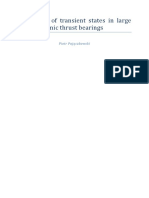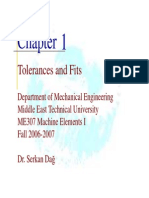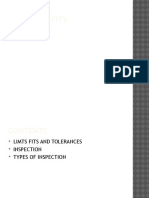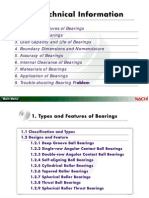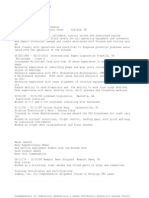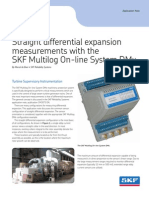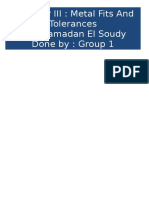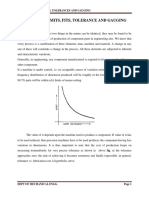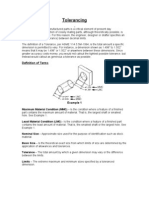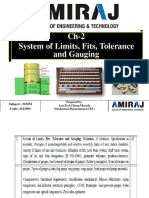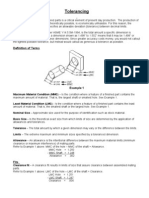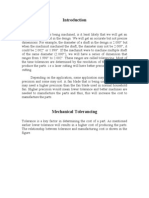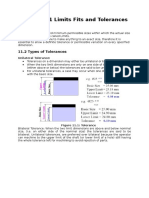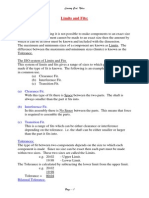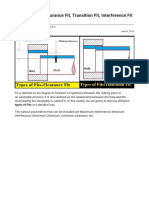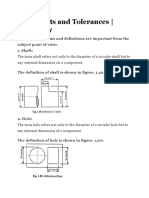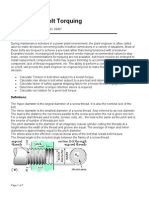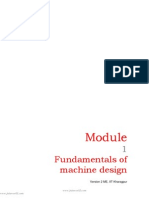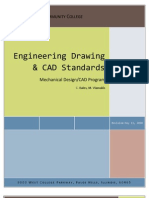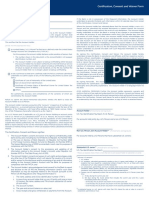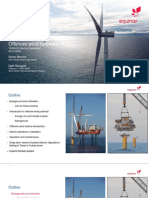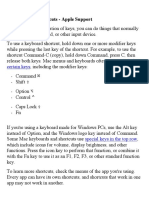Fit and Tolerances
Fit and Tolerances
Uploaded by
Rajasekaran VtCopyright:
Available Formats
Fit and Tolerances
Fit and Tolerances
Uploaded by
Rajasekaran VtOriginal Title
Copyright
Available Formats
Share this document
Did you find this document useful?
Is this content inappropriate?
Copyright:
Available Formats
Fit and Tolerances
Fit and Tolerances
Uploaded by
Rajasekaran VtCopyright:
Available Formats
27
Fit and Tolerances
UNIT 3 FIT AND TOLERANCES
Structure
3.1 Introduction
Objectives
3.2 Fits and their Classifications
3.2.1 Clearance Fit
3.2.2 Interference Fit
3.2.3 Transition Fit
3.3 Systems of Fit
3.4 Tolerance and its Classification
3.4.1 Unilateral Tolerance
3.4.2 Bilateral Tolerance
3.5 Tolerance of Form and Position
3.5.1 Geometrical Tolerances
3.5.2 Tolerances of Angles
3.6 Summary
3.7 Key Words
3.8 Answers to SAQs
3.1 INTRODUCTION
In the early days, majority of the components were actually matted together, their
dimensions being adjusted until the required type of fit was obtained. But with the
passage of time, engineers and workers realized that the variations in the sizes of the
parts had always present and that such variations could be restricted but not avoided. It
has also been realized that exact size components are difficult to produce. Any attempt
towards very closed dimensions of a product will increase cost of the production. The
functional aspects of the component may be achieved even without going for its exact
dimensions using limits, fit and tolerances. This reduces the unit cost of production and
increases the rate of production.
For example, a shaft of exact 10.00 mm diameter is difficult to produce by machining
process. But if you provide tolerence, i.e. the amount of variation permitted in the size,
then such parts can be easily produced. A dimension 10 0.05 means a shaft may be
produced between 10.05 and 9.95. These two figures represent limit and the difference,
(10.05 9.95) = 0.10 is called tolerence.
Objectives
After studying this unit, you should be able to
- understand the basic principles of fits and tolerances,
- explain various types of fits and their applications,
- analyse the various types of tolerances and applications, and
- know the fundamental of the systems of fits.
3.2 FITS AND THEIR CLASSIFICATIONS
When two parts are to be assembled, the relation resulting from the difference between
their sizes before assembly is called a fit. A fit may be defined as the degree of tightness
and looseness between two mating parts.
28
Metrology and
Instrumentation
The important terms related to the fit are given below :
Clearance
In a fit, this is the difference between the sizes of the hole and the shaft, before
assembly, when this difference is positive. The clearance may be maximum
clearance and minimum clearance. Minimum clearance in the fit is the difference
between the maximum size of the hole and the minimum size of the shaft.
Interference
It is the difference between the sizes of the hole and the shaft before assembly,
when the difference is negative. The interference may be maximum or minimum.
Maximum interference is arithmetical difference between the minimum size of the
hole and the maximum size of the shaft before assembly. Minimum interference is
the difference between the maximum size of the hole and the minimum size of the
shaft.
Transition
It is between clearance and interference, where the tolerence zones of the holes
and shaft overlap.
So, you can see that fits depend upon the actual limits of the hole and or shaft and can be
divided into three general classes :
(i) Clearance Fit.
(ii) Interference Fit.
(iii) Transition Fit.
3.2.1 Clearance Fit
In clearance fit, an air space or clearance exists between the shaft and hole as shown in
Figure 3.1. Such fits give loose joint. A clearance fit has positive allowance, i.e. there is
minimum positive clearance between high limit of the shaft and low limit of the hole.
Figure 3.1 : Clearance Fit
Clearance fit can be sub-classified as follows :
Loose Fit
It is used between those mating parts where no precision is required. It provides
minimum allowance and is used on loose pulleys, agricultural machineries etc.
Running Fit
For a running fit, the dimension of shaft should be smaller enough to maintain a
film of oil for lubrication. It is used in bearing pair etc. An allowance 0.025 mm
per 25 mm of diameter of boaring may be used.
Hole
Shaft
29
Fit and Tolerances
Slide Fit or Medium Fit
It is used on those mating parts where great precision is required. It provides
medium allowance and is used in tool slides, slide valve, automobile parts, etc.
Example 3.1
A spindle slides freely in a bush. The basic size of the fit is 50 10
3
mm. If the
tolerances quoted are
0
62 +
for the holes and
80
180
for the shaft, find the upper
limit and lower limit of the shaft and the minimum clearance.
Solution
Tolerances are given in units of one thousandth of millimeter, so the upper limit of
the hole will be 50.062 mm and lower limit for the hole is the same as the basic
size of 50.000 mm.
The shaft upper limit will be (50.000 0.080) 10
3
= 49.92 10
3
m
The shaft lower limit will be (50.000 0.180) 10
3
= 49.82 10
3
m
The minimum clearance or allowance is (50.000 49.920) 10
3
= 8 10
5
mm.
3.2.2 Interference Fit
A negative difference between diameter of the hole and the shaft is called interference.
In such cases, the diameter of the shaft is always larger than the hole diameter. In
Figure 3.2. Interference fit has a negative allowance, i.e. interference exists between the
high limit of hole and low limit of the shaft.
Figure 3.2 : Interference Fit
In such a fit, the tolerance zone of the hole is always below that of the shaft. The shaft is
assembled by pressure or heat expansion.
The interference fit can be sub-classified as follows :
Shrink Fit or Heavy Force Fit
It refers to maximum negative allowance. In assembly of the hole and the shaft,
the hole is expanded by heating and then rapidly cooled in its position. It is used in
fitting of rims etc.
Medium Force Fit
These fits have medium negative allowance. Considerable pressure is required to
assemble the hole and the shaft. It is used in car wheels, armature of dynamos etc.
Tight Fit or Press Fit
One part can be assembled into the other with a hand hammer or by light pressure.
A slight negative allowance exists between two mating parts (more than wringing
fit). It gives a semi-permanent fit and is used on a keyed pulley and shaft, rocker
arm, etc.
Hole
Shaft
30
Metrology and
Instrumentation
Example 3.2
A dowel pin is required to be inserted in a base. For this application H 7 fit for
hole and a p 6 fit for the shaft are chosen. The tolerance quoted are
0
25 +
for the
hole and
26
42 +
for the shaft. Find the upper and lower limits of the hole and also
dowel pin, and the maximum interference between dowel pin and the hole. The
basic size of the fit is 50 10
3
m.
Solution
The upper limit for the hole will be (50.000 + 0.025) 10
3
= 50.025 10
3
m
The lower limit for the hole will be (50.000 + 0) 50.000 10
3
= 50 10
3
m
The upper limit for dowel pin will be (50.000 + 0.042) 10
3
= 50.042 10
3
m
The lower limit for dowel pin will be (50.000 + 0.026) 10
3
= 50.026 10
3
mm
The maximum interference between dowel pin and the hole is
(50.042 50.000) 10
3
= 0.042 10
3
m = 42 10
6
m.
3.2.3 Transition Fit
It may result in either clearance fit or interference fit depending on the actual value of
the individual tolerances of the mating components. Transition fits are a compromise
between clearance and interference fits. They are used for applications where accurate
location is important but either a small amount of clearance or interference is
permissible. As shown in Figure 3.3, there is overlapping of tolerance zones of the hole
and shaft.
Figure 3.3 : Transition Fit
Transition fit can be sub-classified as follows :
Push Fit
It refers to zero allowance and a light pressure (10 cating dowels, pins, etc.) is
required in assembling the hole and the shaft. The moving parts show least
vibration with this type of fit. It is also known as snug fit.
Force Fit or Shrink Fit
A force fit is used when the two mating parts are to be rigidly fixed so that one
cannot move without the other. It either requires high pressure to force the shaft
into the hole or the hole to be expanded by heating. It is used in railway wheels,
etc.
Wringing Fit
A slight negative allowance exists between two mating parts in wringing fit. It
requires pressure to force the shaft into the hole and gives a light assembly. It is
used in fixing keys, pins, etc.
Hole
Shaft
31
Fit and Tolerances
Example 3.3
For a particular application, an H 7 fit has been selected for the hole and a K 6 fit
for the shaft. The tolerance quoted are
0
25 +
for the hole and
12
18 +
for the shaft.
Find the upper limit and lower limit for the hole and also for bush. The basic size
of fit is 50 10
3
m.
Solution
The upper limit for the hole will be (50.000 + 0.025) 10
3
= 50.025 10
3
m.
The lower limit for the hole will be (50.000 + 0) 10
3
= 50.000 10
3
m.
The upper limit for the bush will be (50.000 + 0.018) 10
3
= 50.018 10
3
m.
The lower limit for the bush will be (50.000 + 0.002) 10
3
= 50.002 10
3
m.
3.3 SYSTEMS OF FIT
A fit system is the systems of standard allowance to suit specific range of basic size. If
these standard allowances are selected properly and assigned in mating parts ensures
specific classes of fit.
There are two systems of fit for obtaining clearance, interference or transition fit. These
are :
(i) Hole basis system (Figure 3.4)
(ii) Shaft basis system (Figure 3.5)
Figure 3.4 : Hole Basis System
Figure 3.5 : Shaft Basis System
Interference Fit
Transition Fit
Clearance Fit
Interference Fit Transition Fit Clearance Fit
32
Metrology and
Instrumentation
Hole Basis System
In the hole basis system, the size of the hole is kept constant and shaft sizes are
varied to obtain various types of fits.
In this system, lower deviation of hole is zero, i.e. the low limit of hole is same as
basic size. The high limit of the hole and the two limits of size for the shaft are
then varied to give desired type of fit.
The hole basis system is commonly used because it is more convenient to make
correct holes of fixed sizes, since the standard drills, taps, reamers and branches
etc. are available for producing holes and their sizes are not adjustable. On the
other hand, size of the shaft produced by turning, grinding, etc. can be very easily
varied.
Shaft Basis System
In the shaft basis system, the size of the shaft is kept constant and different fits are
obtained by varying the size of the hole. Shaft basis system is used when the
ground bars or drawn bars are readily available. These bars do not require further
machining and fits are obtained by varying the sizes of the hole.
In this system, the upper deviation (fundamental deviation) of shaft is zero, i.e. the
high limit of the shaft is same as basic size and the various fits are obtained by
varying the low limit of shaft and both the limits of the hole.
SAQ 1
(a) What is a fit?
(b) What is the difference between clearance and interference?
(c) Mention the applications of clearance, interference and transitions fits.
(d) Which of the following are clearance, transition and interference fits?
(i) Push fit,
(ii) Wringing fit,
(iii) Force fit, and
(iv) Slide fit.
(e) Differentiate between Hole basis system and Shaft basis system.
(f) A clearance fit is required between the mating parts with hole, specified as
0.04
0.00
25
+
mm and shaft
0.02
0.04
25
mm.
Find maximum and minimum permissible size of the hole and also for the
shaft.
3.4 TOLERANCE AND ITS CLASSIFICATION
The permissible variation in size or dimension is tolerance. Thus, the word tolerance
indicates that a worker is not expected to produce the part of the exact size, but definite a
small size error is permitted. The difference between the upper limit (high limit) and the
lower limit of a dimension represents the margin for variation to workmanship, and is
called a tolerance zone (Figure 3.6).
Tolerance can also be defined as the amount by which the job is allowed to go away
from accuracy and perfectness without causing any functional trouble, when assembled
with its mating part and put into actual service.
33
Fit and Tolerances
Example 3.4
A shaft of 25 mm basic size is given as 25 0.02 mm. Find the tolerance.
Solution
The maximum permissible size (upper limit) = 25.02 mm and the minimum
permissible size (lower limit) = 24.98 mm
Then, Tolerance = Upper Limit Lower Limit
= 25.02 24.98
= 0.04 mm = 4 10
5
m
There are two ways of writing tolerances
(a) Unilateral tolerance
(b) Bilateral tolerance.
Figure 3.6 : Tolerance
3.4.1 Unilateral Tolerance
In this system, the dimension of a part is allowed to vary only on one side of the basic
size, i.e. tolerance lies wholly on one side of the basic size either above or below it
(Figure 3.7).
Figure 3.7 : Unilateral Tolerance
Examples of unilateral tolerance are :
0.02 0.02 0.01 0.0
0.01 0.01 0.02 0.02
25 , 25 , 25 , 25
+ +
+
etc.
Unilateral system is preferred in interchangeable manufacture, especially when precision
fits are required, because
(a) it is easy and simple to determine deviations,
(b) another advantage of this system is that Go Gauge ends can be
standardized as the holes of different tolerance grades have the same lower
limit and all the shafts have same upper limit, and
(c) this form of tolerance greatly assists the operator, when machining of
mating parts. The operator machines to the upper limit of shaft (lower limit
for hole) knowing fully well that he still has some margin left for machining
before the parts are rejected.
Tolerance
Lower Limit
Upper Limit
Basic Size
Tolerance
Tolerance
34
Metrology and
Instrumentation
3.4.2 Bilateral Tolerance
In this system, the dimension of the part is allowed to vary on both the sides of the basic
size, i.e. the limits of tolerance lie on either side of the basic size, but may not be
necessarily equally dispose about it (Figure 3.8).
Figure 3.8 : Bilateral Tolerance
Examples of bilateral tolerance are :
0.02 0.02
0.01
25 , 25
+
etc.
In this system, it is not possible to retain the same fit when tolerance is varied and the
basic size of one or both of the mating parts are to be varied. This system is used in mass
production when machine setting is done for the basic size.
Example 3.5
A 50 mm diameter shaft is made to rotate in the bush. The tolerances for both
shaft and bush are 0.050 mm. Determine the dimension of the shaft and bush to
give a maximum clearance of 0.075 mm with the hole basis system.
Solution
In the hole basis system, lower deviation of hole is zero, therefore low limit of
hole = 50 mm.
High limit of hole = Low limit + Tolerance
= 50.00 + 0.050
= 50.050 mm = 50.050 10
3
m
High limit of shaft = Low limit of hole Allowance
= 50.00 0.075
= 49.925 mm = 49.925 10
3
m
Low limit of the shaft = High limit Tolerance
= 49.925 0.050
= 49.875 mm = 49.875 10
3
m
The dimension of the system is shown in Figure 3.8.
Figure 3.8 : Shaft with Bush
Example 3.5
For each of the following hole and shaft assembly, find shaft-tolerance, hole
tolerance and state whether the type of fit is
Tolerance
Tolerance
Basic Size
0.075
0.05 mm
0.05 mm
35
Fit and Tolerances
(a) clearance,
(b) transition, and
(c) interference:
(i) Hole : mm
005 . 0
05 . 0
50 : Shaft , mm
00 . 0
25 . 0
50
+
+
+
+
(ii) Hole :
0.05 0.02
30 mm, Shaft : 30 mm
0.00 0.05
+
+ +
(iii) Hole :
+0.04 +0.06
25 mm, Shaft : 25 mm
+0.00 +0.04
Solution
(a) Hole : High limit of hole = 50.025 mm
Low limit of hole = 50.00 mm
Hole tolerance = 50.025 50.00
= 0.025 mm = 25 10
6
m
Shaft : High limit of shaft = 50.05 mm
Low limit of shaft = 50.005 mm
Shaft tolerance = 50.05 50.005
= 0.045 mm 45 10
6
m
If we choose high limit of hole with high limit of shaft then
Allowance = 50.025 50.05
= 0.025 (Interference)
Similarly, if we choose low limit of hole and either high limit or low limit
of shaft, it is clear that there will be interference.
Thus, we conclude that the type of fit is Transition fit.
(b) Hole : High limit = 30.05 mm
Low limit = 30.00 mm
Tolerance = 0.05 mm = 5 10
5
m
Shaft : High limit = 30 0.02 = 29.98 mm
Low limit = 30 0.05 = 29.95 mm
Tolerance = 29.98 29.95 = 0.0 3 mm = 3 10
5
m
If we select high limit of hole and high limit of shaft then
Allowance = 30.05 29.98 = 0.07 mm
If we choose low limit of hole and high limit of shaft then
Allowance = 30.00 29.98 = 0.02 mm
Thus, we conclude that the type of fit is Clearance fit.
(c) Hole : High limit = 25.04 mm
Low limit = 25.00 mm
Tolerance = 25.04 25.00
= 0.04 mm = 4 10
5
m
36
Metrology and
Instrumentation
Shaft : High limit = 5.06 mm
Low limit = 25.04 mm
Tolerance = 25.06 25.04
= 0.02 mm = 2 10
5
m
If we select high limit of shaft and low limit of hole, then
Allowance = 25.00 25.06
= 0.06 mm = 6 10
5
m
It is clear that for any combination of hole and shaft the allowance will be
negative.
Thus, we conclude that the type of fit is Interference fit.
3.5 TOLERANCE OF FORM AND POSITION
It defines the zone within which a geometrical element should be specified in
geometrical features, in addition to linear tolerance. Table 3.1 specifies tolerance of form
and Table 3.2 specifies tolerance of position.
Table 3.1 : Symbol Specifying the Shape (Tolerance of Form)
Types of Error Symbol
Briefly Interpretation
Flatness Deviation from a flat Surface
Straighness Deviation from a straight line
Cylindricality Deviation from true cylinder O
Circularity or roundness Deviation from true circle O
Accuracy of any surface
c
Table 3.2 : Symbol Specifying the Relative Location (Tolerance of Position)
Types of Error Symbol
Briefly Interpretation
Parallelism Lack of parallelism //
Squareness and Perpendicularity Lack of squareness
Concentricity Lack of concentricity
Symmetry Lack of symmetry
3.5.1 Geometrical Tolerances
Geometric means geometric forms such as a plane, cylinder, square, etc. Geometrical
features are : flatness, straightness, squareness etc. Geometrical tolerances refer to the
shape of the surfaces (tolerance of form) as well as the relative location of one feature to
another (tolerance of position). These tolerances are specified by special symbols (refer
Tables 3.1 and 3.2).
Geometrical tolerances are specified for geometrical features, in addition to linear
tolerances. Data about the tolerances on the shape and location of surfaces are indicated
on drawings in a rectangular box divided into two or three parts. For example Lack
parallelism between two surfaces is within 0.1 mm can be written as
/ 0.1
37
Fit and Tolerances
Examples of geometrical tolerances are given below :
Parallelism (Figure 3.9(a))
It indicates the requirement, Surface A is parallel to opposite face within 0.1 mm.
Straightness (Figure 3.9(b))
It indicates the requirement, Straight within 0.02 mm.
Squareness (Figure 3.9(c))
It indicates the requirement, Square within 0.03 mm total.
Flatness (Figure 3.9(d))
It indicates the requirement, Flat within 0.002 mm total.
Roundness (Figure 3.9(e))
It indicates the requirement, Taper round within 0.01 mm.
(a) (b)
(c) (d)
(e)
Figure 3.9 : Geometrical Tolerances
A
50
20.02
20.00
// 0.1 A
0.0
2
0.03
0 0.0
0.02
38
Metrology and
Instrumentation
3.5.2 Tolerances of Angles
Angular tolerances are generally indicated in terms of degrees, minutes and seconds.
Angular tolerances are used to give an angular dimension with high accuracy as shown
in Figure 3.10. These are usually bilateral.
Figure 3.10 : Tolerance of Angles
SAQ 2
(a) Why it is necessary to give tolerance on engineering dimension?
(b) Explain the unilateral and bilateral system of writing tolerances with
suitable examples.
(c) What is the difference between tolerance of form and position?
(d) What are geometrical tolerances? How are they specified? Give examples.
(e) In a hole and shaft assembly of 30 mm nominal size, the tolerances for hole
and shaft are as specified below :
mm
70 . 0
40 . 0
30 : Shaft , mm
00 . 0
02 . 0
30 : Hole
+
Determine :
(i) Maximum and minimum clearance obtainable.
(ii) Hole and shaft tolerance, and
(iii) The type of fit.
3.6 SUMMARY
The aspects of various types of limits, fits and tolerances are very useful in reducing the
unit cost of production and increasing the rate of production.
A fit may be defined as the degree of tightness or looseness between two mating parts.
The fits depend upon the actual limits of the hole and/or shaft and can be divided into
three general categories :
(a) Clearance fit,
(b) Interference fit, and
(c) Transition fit.
A fit system is the systems of standard allowance to suit specific range of basic size. If
these standard allowances are selected properly and assigned in mating parts ensures
specific classes of fit. There are two systems of fit for obtaining clearance, interference
or transition fit. These are
(a) Hole basis system, and
(b) Shaft basis system.
90
o
1
o
30
o
20' 30
o
40
39
Fit and Tolerances
Tolerance can be fixed as the amount by which the job is allowed to go away from
accuracy and perfectness without causing any functional trouble, when assembled with
its mating part and put into actual service. There are two ways of writing tolerances :
Unilateral tolerance and Bilateral tolerance. Geometrical tolerance refers to the shape of
the surfaces as well as the relative location of one feature to another.
Angular tolerances are used to give an angular dimension with high accuracy. Angular
tolerances are generally indicated in terms of degrees, minutes and seconds.
3.7 KEY WORDS
Limit : Permissible size.
Fit : The degree of tightness or looseness between two
mating parts.
Clearance : The positive difference between the sizes of the
hole and shaft before assembly.
Interference : The negative difference between the sizes of the
hole and shaft before the assembly.
Transition : It is tolerance zone where the hole and shaft
overlap.
Tolerance : The permissible variation in size or dimension.
3.8 ANSWERS TO SAQs
SAQ 1
(a) A fit indicates the degree of tightness or looseness between two mating
parts.
(b) A clearance is the positive difference between the hole and shaft before
assembly whereas a negative difference between the hole and shaft for the
same is called interference.
(c)
Sl. No. Type of Fit Application
1. Clearance Pulleys, slide valve
2. Interference Rims, car wheels,
3. Transition Railway wheels, fixing keys,
pins etc.
(d)
Sl. No. Type of Fit Application
1. Push fit Transition fit
2. Wringing fit Transition fit
3. Force fit Interference fit
4. Slide fit Clearance fit
(e) In the hole basis system, the size of the hole is kept constant and shaft sizes
are varied to obtain various types of fit, whereas in the shaft basis system,
the size of the shaft is kept constant and the different fits are obtained by
varying the size of the hole.
40
Metrology and
Instrumentation
(f) The upper limit of hole = 25 + 0.04
= 25.04 mm.
The lower limit of the hole = 25 0.04
= 24.96 mm.
The maximum permissible size of the shaft = 25 0.02
= 24.98 mm = 24 9.8 10
3
m.
The minimum permissible size of the shaft = 25 0.04
= 24.96 mm = 24.96 10
3
m.
SAQ 2
(a) It is necessary to give tolerance on engineering dimension, so that the
mating parts can be easily produced without causing any functional trouble.
(b) In unilateral system, the dimension of a part is allowed to vary only on one
size of the basic size, i.e. tolerance lies wholly on one side of the basic size
either above or below it.
Example
+ 0.04 +0.04
+ 0.02 0.02
25 mm, 25 mm
In bilateral system, the dimension of the part is allowed to vary on
both the sides of the basic size, i.e. the limits of tolerance lie on either
side of the basic size.
Example
+ 0.02
0.02 0.01
25 mm, 25 mm
(c) Tolerance of form specifies the geometrical shape but tolerance of position
specifies the relative location.
(d) Geometrical tolerances refer to the shape of the surfaces as well as the
relative location of one feature to another.
Geometrical tolerances are specified for geometrical features in addition to
linear references.
For example Lack parallelism between the surfaces is within 0.1 mm can
be written as
/ 0.1
(e) (i) Maximum clearance = 30.02 29.93
= 0.09 mm
Minimum clearance = 30.00 29.96
= 0.04 mm
(ii) High limit of hole = 30.02 mm
Low limit of hole = 30.00 mm
Hole tolerance = 30.02 30.00
= 0.02 mm = 2 10
3
m
High limit of shaft = 30 0.04
= 29.96 mm
41
Fit and Tolerances
Low limit of shaft = 30 0.070
= 29.93 mm
Shaft Tolerance = 29.96 29.93
= 0.03 mm = 3 10
5
m
(iii) If we consider high limit of hole with high limit of shaft, then
allowance = 30.02 29.96
= 0.06 mm
If we choose low limit of hole and either high limit or low limit of
shaft then the allowance is positive in each case, i.e.
30 29.96 = + 0.04 mm = + 4 10
5
m
or 30 29.93 = + 0.07 mm = + 7 10
3
m
Hence, the type of fit is clearance fit.
You might also like
- Pornhub and Modelhub Co-Performer Agreement PDFDocument2 pagesPornhub and Modelhub Co-Performer Agreement PDFPanther World14367% (6)
- Environmental Life Cycle AnalysisDocument158 pagesEnvironmental Life Cycle Analysismaheshperiyasamy100% (2)
- Thrust Bearing CalculationsDocument162 pagesThrust Bearing Calculationslahiru1983100% (1)
- Chapter III: Metal Fits and Tolerances DR: Ramadan El Soudy Done By: Group 1Document15 pagesChapter III: Metal Fits and Tolerances DR: Ramadan El Soudy Done By: Group 1Karim MagdyNo ratings yet
- Pokemon Black Action Replay CheatsDocument25 pagesPokemon Black Action Replay Cheatsricky_rexi100% (1)
- Lecture11 Limit, Fit & Tolerance BETP2503 Sem1 2015-2016 PDFDocument46 pagesLecture11 Limit, Fit & Tolerance BETP2503 Sem1 2015-2016 PDFArecap CoolNo ratings yet
- (Tambahan) Tolerances - FitsDocument25 pages(Tambahan) Tolerances - FitsMuhammad Fachry RamadhanyNo ratings yet
- Limits Fits and Tolerances MetrologyDocument24 pagesLimits Fits and Tolerances MetrologyAnkushNo ratings yet
- 18-Limit, Fit, ToleranceDocument15 pages18-Limit, Fit, ToleranceMitul75% (4)
- BearingDocument326 pagesBearingdhirajchhetri2010100% (1)
- Vertical Shaft Laser AlignmentDocument0 pagesVertical Shaft Laser AlignmentDelfinshNo ratings yet
- Ludeca Smartalign BrochureDocument8 pagesLudeca Smartalign BrochureNestor LopezNo ratings yet
- Ludeca Best Practices Machinery Alignment ShimmingDocument7 pagesLudeca Best Practices Machinery Alignment ShimmingTimber RamNo ratings yet
- Industrial Mechanic or MillwrightDocument2 pagesIndustrial Mechanic or Millwrightapi-78886667No ratings yet
- Home About Us Software Services Training Download Pricing Bolting InfoDocument9 pagesHome About Us Software Services Training Download Pricing Bolting Infopaeg6512No ratings yet
- Bearing FitsDocument9 pagesBearing Fitstaekwangkim4907100% (1)
- Ludeca Vertical Turbine Bearing AlignmentDocument6 pagesLudeca Vertical Turbine Bearing AlignmentSivananthaa MurtheeNo ratings yet
- Mastertech1 PDFDocument4 pagesMastertech1 PDFDiego AlejandroNo ratings yet
- Assured Automation Automated Valves OxlerDocument26 pagesAssured Automation Automated Valves OxlerMarcio RochaNo ratings yet
- Limits Fits and ToleranceDocument18 pagesLimits Fits and ToleranceMuhammad Waseem SoomroNo ratings yet
- Torsion BarDocument2 pagesTorsion BardownloadlagumNo ratings yet
- Coupling Design and SelectionDocument11 pagesCoupling Design and SelectionVivek RathodNo ratings yet
- Tolerance - Limit FitDocument13 pagesTolerance - Limit FitArun V NairNo ratings yet
- Lord Fan Balancer PresentationDocument32 pagesLord Fan Balancer PresentationEzhil Vendhan PalanisamyNo ratings yet
- Straight Differential Expansion - DMXDocument4 pagesStraight Differential Expansion - DMXJurun_BidanshiNo ratings yet
- Thermal Power Plant TrainingDocument18 pagesThermal Power Plant TrainingAnkit Surana0% (1)
- Gears Their Designs & Uses: Andrei Lozzi 2012Document23 pagesGears Their Designs & Uses: Andrei Lozzi 2012atulsemiloNo ratings yet
- JMT Welding Positioner CatalogDocument8 pagesJMT Welding Positioner Catalogazeez basha100% (1)
- D04 Shaft Deflection Runout Vibration and Axial MotionDocument15 pagesD04 Shaft Deflection Runout Vibration and Axial Motionsuraj dhulannavarNo ratings yet
- Shearing and Bending IntroductionDocument30 pagesShearing and Bending IntroductionmoriyasurjpNo ratings yet
- Shaft AlignmentDocument20 pagesShaft AlignmentmersiumNo ratings yet
- Pres 2Document15 pagesPres 2Karim MagdyNo ratings yet
- MODULE 2-System of Limits, Fits, TolerancesDocument18 pagesMODULE 2-System of Limits, Fits, TolerancesjishnushankarNo ratings yet
- Tolerancing: Definition of TermsDocument22 pagesTolerancing: Definition of Termsandrawala111No ratings yet
- Chapter 2 - System of Limits Fits Tolerance and GaugingDocument77 pagesChapter 2 - System of Limits Fits Tolerance and Gaugingrajaganesh.c.i.dNo ratings yet
- Analysis and Design DrawingDocument41 pagesAnalysis and Design DrawingBrown MeshNo ratings yet
- Tolerance and Fits (Adjustments)Document13 pagesTolerance and Fits (Adjustments)Brown MeshNo ratings yet
- Fits and TolerenceDocument34 pagesFits and Tolerencerana__singhNo ratings yet
- Tolerancing Notes On 18.9Document29 pagesTolerancing Notes On 18.9Anantha KumarNo ratings yet
- Manufacturing Considerations in Machine DesignDocument29 pagesManufacturing Considerations in Machine Designmartex_37No ratings yet
- Metrology & Instrumentation Course File1Document112 pagesMetrology & Instrumentation Course File1harshith pondeNo ratings yet
- Module 2 - Sizing and DimensioningDocument13 pagesModule 2 - Sizing and Dimensioningfoj90532No ratings yet
- Complete Unit IDocument147 pagesComplete Unit INarender Narru100% (1)
- Limits, Fits and Tolerances - Part 1Document57 pagesLimits, Fits and Tolerances - Part 1Mahesh Pareek100% (2)
- Toler AncingDocument36 pagesToler AncingAnesu ZirerezaNo ratings yet
- Fits and ToleranceDocument5 pagesFits and ToleranceAbdullrahman ElkhatebNo ratings yet
- ME 114 - Engineering Drawing II: Fits, Tolerances and Surface Quality MarksDocument19 pagesME 114 - Engineering Drawing II: Fits, Tolerances and Surface Quality MarksMuhamad Richard MenarizkiNo ratings yet
- GD&T, Mechanical TolerancingDocument12 pagesGD&T, Mechanical TolerancingsandeshbhavsarNo ratings yet
- Limits Fits and TolerencesDocument12 pagesLimits Fits and TolerencesAkhil Nandan VermaNo ratings yet
- Unit 1 - System of Limits Fits and Tolerences-1Document58 pagesUnit 1 - System of Limits Fits and Tolerences-1Shayan ChowdaryNo ratings yet
- Belt Conveyor Pulley Design - Why The Failures - Terry KingDocument11 pagesBelt Conveyor Pulley Design - Why The Failures - Terry KingJakesNo ratings yet
- Unit2 - Limits Fits & Tolerance NotesDocument19 pagesUnit2 - Limits Fits & Tolerance NotesvrmgiteduNo ratings yet
- Limits and Fits HandoutDocument6 pagesLimits and Fits HandoutdrthuhanNo ratings yet
- LIMITS, Tolerance and FitsDocument9 pagesLIMITS, Tolerance and FitsAshelNo ratings yet
- Types of Fits - Clearance Fit, Transition Fit, Interference Fit (PDF)Document8 pagesTypes of Fits - Clearance Fit, Transition Fit, Interference Fit (PDF)RanendraRoyNo ratings yet
- ToleranceDocument7 pagesTolerancemanish422No ratings yet
- LECTURE 2B Limits and Fits NewDocument17 pagesLECTURE 2B Limits and Fits Newmanishkrbarnwal13No ratings yet
- Limits, Fits and Tolerances - MetrologyDocument12 pagesLimits, Fits and Tolerances - MetrologyShakibNo ratings yet
- Present 2Document24 pagesPresent 2MMSRITNo ratings yet
- Cross-Section of A Machine-Tool SlidewayDocument31 pagesCross-Section of A Machine-Tool SlidewayTushar LanjekarNo ratings yet
- Bolt Torquing AnalysisDocument7 pagesBolt Torquing AnalysisEleonor Maderazo100% (1)
- Madhav Institute OF Technology and Science Gwalior: "Limits Fits and Tolerance"Document18 pagesMadhav Institute OF Technology and Science Gwalior: "Limits Fits and Tolerance"Jaideep SinghNo ratings yet
- Design of Machine Members - I NotesDocument495 pagesDesign of Machine Members - I NotesNaveen SuryaNo ratings yet
- ProbabilityDistributions 61Document61 pagesProbabilityDistributions 61Rmro Chefo LuigiNo ratings yet
- Engineering Drawing & CAD Standards Mechanical Design/CAD Program C. Bales, M. VlamakisDocument24 pagesEngineering Drawing & CAD Standards Mechanical Design/CAD Program C. Bales, M. VlamakisRajasekaran VtNo ratings yet
- 19 Introduction To Design of Helical SpringsDocument12 pages19 Introduction To Design of Helical SpringsPRASAD326100% (3)
- Tolerance Analysis ExtensionDocument2 pagesTolerance Analysis ExtensionRajasekaran VtNo ratings yet
- Principles of Precision Machine DesignDocument493 pagesPrinciples of Precision Machine DesignWisdom Patrick Enang100% (3)
- The Spatial and Temporal Distributions of U.S. Winds and Windpower at 80 M Derived From MeasurementsDocument52 pagesThe Spatial and Temporal Distributions of U.S. Winds and Windpower at 80 M Derived From MeasurementsRajasekaran VtNo ratings yet
- Statistical TechniquesDocument41 pagesStatistical TechniquesAnindito W WicaksonoNo ratings yet
- Contempt of CourtDocument12 pagesContempt of CourtAbhijeetMishraNo ratings yet
- The International Maritime Human Element BulletinDocument8 pagesThe International Maritime Human Element BulletinManoj VarrierNo ratings yet
- Lumileds Demo LED Bulbs and Modules LeafletDocument2 pagesLumileds Demo LED Bulbs and Modules LeafletAkbar ZuhriNo ratings yet
- INVT P2 ManualDocument20 pagesINVT P2 ManualmarlonrafaelNo ratings yet
- Chapter 1: System EnvironmentDocument7 pagesChapter 1: System EnvironmentBijay MishraNo ratings yet
- Search of Moving VehicleDocument1 pageSearch of Moving VehicleVauge Jill Loontey0% (1)
- JSP QuestionsDocument6 pagesJSP Questionsapi-3831588No ratings yet
- Nanay Bridge PERUDocument9 pagesNanay Bridge PERUIvan Yañez SepulvedaNo ratings yet
- d6 SwitchDocument4 pagesd6 Switchtheantelopet22No ratings yet
- Contoh Case Study 2 - Eternal TravelDocument4 pagesContoh Case Study 2 - Eternal TravelSteffi DorothyNo ratings yet
- Exibit 1 - Certification Consent WaiverDocument1 pageExibit 1 - Certification Consent WaiverSteve LimNo ratings yet
- Promet U ManualDocument48 pagesPromet U Manualmrnoboby0407No ratings yet
- bf0128731920161209 27245 Amvoze With Cover Page v2Document13 pagesbf0128731920161209 27245 Amvoze With Cover Page v2Latify NazirNo ratings yet
- Strategic Management Notes (Starbucks)Document9 pagesStrategic Management Notes (Starbucks)Saqib Saqlain TahirNo ratings yet
- Pfaff 125 Sewing Machine Instruction ManualDocument86 pagesPfaff 125 Sewing Machine Instruction ManualiliiexpugnansNo ratings yet
- Marine Operations - Offshore Wind 2020 - NewDocument88 pagesMarine Operations - Offshore Wind 2020 - NewManoj Gupta100% (1)
- 11 - Nelson - Theories of Regional DevelopmentDocument17 pages11 - Nelson - Theories of Regional DevelopmentFransisko MexdanNo ratings yet
- Durapore 33 MM MillexDocument4 pagesDurapore 33 MM MillexSigit SadewoNo ratings yet
- 2009 - Kline & SulskyDocument11 pages2009 - Kline & SulskyMónica Hevia FredesNo ratings yet
- HT Capacitor Sizing-MotorDocument7 pagesHT Capacitor Sizing-MotorSamarjit Narayan Chowdhury100% (1)
- C711 - MPS711 RSPL - Rev19Document23 pagesC711 - MPS711 RSPL - Rev19Suporte RZ InformáticaNo ratings yet
- Trade Test Class 1Document7 pagesTrade Test Class 1Godfrey Masumbika100% (1)
- Smart Electrical Panel - ENDocument16 pagesSmart Electrical Panel - ENValcu Gabriel OctavianNo ratings yet
- Mac Keyboard SHORTCATSDocument8 pagesMac Keyboard SHORTCATSQuzzaq SebaNo ratings yet
- Go MS No 178Document8 pagesGo MS No 178Ravi Teja RTNo ratings yet
- Performance Management - With ExamplesDocument22 pagesPerformance Management - With ExamplesFalcon City100% (1)


